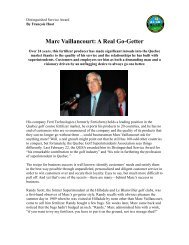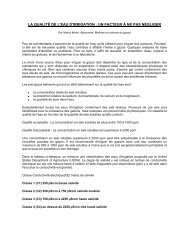Le 1er salon de l - Association des Surintendants de Golf du Québec
Le 1er salon de l - Association des Surintendants de Golf du Québec
Le 1er salon de l - Association des Surintendants de Golf du Québec
- No tags were found...
Create successful ePaper yourself
Turn your PDF publications into a flip-book with our unique Google optimized e-Paper software.
Lionel Langevin, who gave me his support. Onceagain, I applied and they chose me. I guess theirchoice was the right one, because I’m still here. In2011 I’m starting my 20th year as Superinten<strong>de</strong>ntat Club <strong>de</strong> golf Cap-Rouge.”A source of pri<strong>de</strong>Richard Larochelle is proud—with good reason—of the work that he has done and continues to do,season after season. He is also proud that he hasbeen able to “last” all these years, to use his ownexpression, complete with his share of snowstorms,and that he and his teams have contributedin their own ways to the success of the clubsthat have entrusted him with their grounds. “Atthe end of the day, it’s all about respect and confi<strong>de</strong>nce.I have seen several superinten<strong>de</strong>nts failto get along with club directors, and vice versa,because the relationship lacked respect and supporton one si<strong>de</strong> or the other. To make it in thisprofession, in my opinion, you have to have solidtraining in several different areas (soil, plants, physiology,hydraulics, mechanics, personnel management,human relations, fertilizers, antiparasiticpro<strong>du</strong>ct and water management), have a goodteam supporting you, and be able to take advantageof important innovations on many fronts(computers, machinery, irrigation systems andpro<strong>du</strong>cts). I am not a computer buff, but I haveto admit that computers make my job easier andallow me to stay informed so I can perform moreeffectively. Everything, from machinery and irrigationsystems to communications and pro<strong>du</strong>cts,changes so fast.”Looking to the future …With all the social and economic changes we’veseen over the last 50 years, not to mention globalwarming, the aging population and manyother factors, it would take a genius to accuratelypredict what the future holds for golf coursesand the profession of superinten<strong>de</strong>nt. In RichardLarochelle’s opinion, the two are closely linked.The future of golf courses <strong>de</strong>pends primarily onmanagement’s ability to invest in facilities butalso, and even more importantly, in the humancapital surrounding it. As for the superinten<strong>de</strong>nt’sprofession, our man from Cap-Rouge believes itis un<strong>de</strong>rgoing a profound transformation. “I thinkthat the number of golf courses has hit a peakand that some are going to be converted to otheruses in the near future. Also, golf club executivesprefer to see superinten<strong>de</strong>nts as managers thesedays, in or<strong>de</strong>r to increase operational efficiency. IfI had one word of advice for the next generation,it would be to make sure they have solid basictraining so that they have the self-assurance theyneed in <strong>de</strong>aling with club executives.”ReciprocityWhile Richard Larochelle is quick to sing the praisesof his Presi<strong>de</strong>nt, Robert Bergeron, and theCap-Rouge club’s official pro, François Sauvé,the reverse is also true. Robert Bergeron has heldthe post of Presi<strong>de</strong>nt for the last two years, buthe has also sat on the Board of Directors for thelast seven years and held the position of ChiefGroundskeeper. His meetings with Cap-Rouge’ssuperinten<strong>de</strong>nt were nearly a daily event. “To getup at 2:45 in the morning and work nearly sevendays a week, you have to love what you do, andthat’s one of Richard’s greatest strengths: his lovefor his work. Over the last two <strong>de</strong>ca<strong>de</strong>s, he hasma<strong>de</strong> enormous improvements to the club bygetting his i<strong>de</strong>as implemented while sticking tohis budget. As our first full-time superinten<strong>de</strong>nt,he has charted a steady course over the last 20years. That’s something every golf club is lookingfor.” Robert Bergeron also says that over theyears, Richard Larochelle has managed to findnew approaches and ways of operating that meetthe new challenges and realities facing today’sgolf clubs. He adds that Richard’s experience andorganizing skills came in very handy in 2005 whenmajor work was getting un<strong>de</strong>r way on rebuildinghole no. 7 and the no. 6 and 13 greens, and makingmany other improvements just in time for theclub’s 50th anniversary in 2009. The Presi<strong>de</strong>ntdoesn’t hi<strong>de</strong> the fact that there are plans for a fewmore projects on the drawing board.A country clubPerched on the highest points of a promontoryjutting out into the St. Lawrence River, Club<strong>de</strong> golf <strong>de</strong> Cap-Rouge was created in 1959 tomeet the pressing need of Sainte-Foy, Silleryand Cap-Rouge resi<strong>de</strong>nts to find a place closerto home where they could play their favouritesport. The i<strong>de</strong>a of starting a «country club» (includinga golf course, tennis courts, a swimmingpool and cross-country ski facilities) in Cap-Rouge was born in the late 1950s, following aconversation between then Cap-Rouge MayorJean-Charles Cantin (the Club’s first Presi<strong>de</strong>nt,1959–1961) and Doctor Wilfrid Caron. Shortly afterwards,two groups of businessmen supportedby the Sainte-Foy chamber of commerce andthe heads of the recreation committee proposedthe purchase of an 8-million-sq.-ft. piece of land.It all came together in early August 1959, withthe first official reception at Club <strong>de</strong> golf <strong>de</strong> Cap-Rouge … even though it was held in a tent. Overtime, the swimming pool and tennis courts havedisappeared.Summer resi<strong>de</strong>nceAt an era when the NHL’s Quebec Nordiques reignedsupreme in Quebec City (1979–1995), mostplayers and coaches chose to settle in the city ofCap-Rouge with their families. The most famous«coach» in Nordiques history, Michel Bergeron,who treated fans to some exciting games at Club<strong>de</strong> golf <strong>de</strong> Cap-Rouge, could speak for hours onend about the twisting fairways, surprising greensand sums of money he won or lost on the course,located almost in his own backyard. One ofthe Nordiques’ founding fathers, Marius Fortier,organized a tournament named after himself atthe club for many years, and many other playersinsisted on playing there free-of-charge, capitalizingon their immense popularity. While the QuebecCity Coliseum was the Nordiques’ home inthe wintertime, their summer resi<strong>de</strong>nce was withoutdoubt Club <strong>de</strong> golf <strong>de</strong> Cap-Rouge.Trevor Bergh B.A, EMPD, CCÈPPresi<strong>de</strong>ntBergh Environmental ConsultingEnvironmental Management for <strong>Golf</strong> CoursesALEXANDRE BASTIENDIRECTEUR DU DÉVELOPPEMENT DES AFFAIRESalexandre.bastien@gazonbastien.com1183 Route 105Chelsea, QuebecJ9B 1P4Phone: 613-277-4603Email: trevor@berghenvironmentalconsulting.caWeb: www.berghenvironmentalconsulting.caTCFgazonbastien.comPrintemps 2011 31


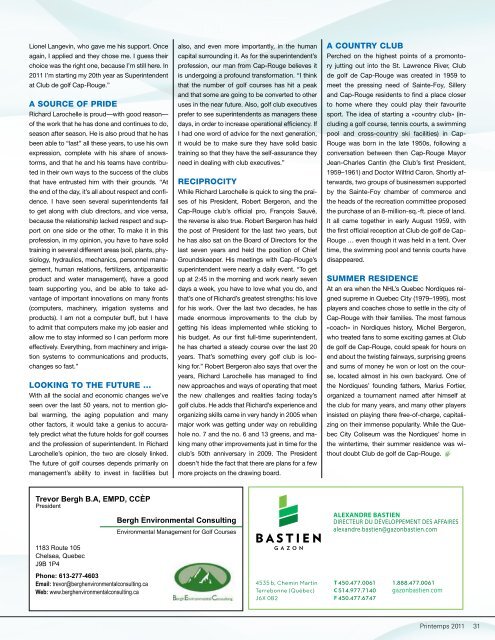


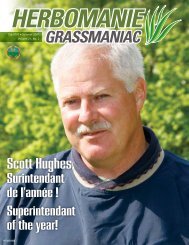
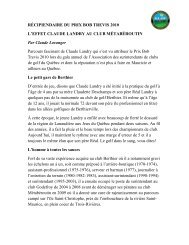
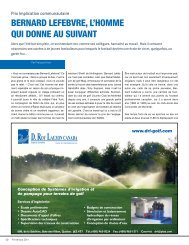




![Prix Bob Trevis - Daniel Read [Mode de compatibilité]](https://img.yumpu.com/38379520/1/190x135/prix-bob-trevis-daniel-read-mode-de-compatibilitac.jpg?quality=85)

